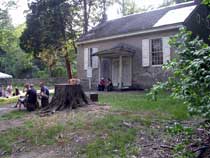
The promotional brochure for “The Lost Meeting” had so many words and was arranged in such a confusing way up and down the page, this way and that that I couldn’t read it. I took in the old-fashioned script which communicated “old” and the indecipherablility which conveyed chaos and accepted it all as part of the art project. Then I worried that the chaos of the brochure boded ill for the project. (image is the abandoned Quaker meetinghouse at Abington Art Center that is the site for “The Lost Meeting.”)
spurse
An art teacher I had once said that it’s not good enough to have great ideas. You have to do something with them — bring them to life and share them with the world. That’s the test of art.
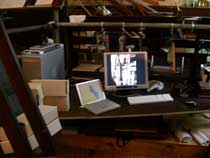
That thought has stayed with me and I always look for art to communicate some great idea. If it does, it’s usually a great piece of art.
The Lost Meeting has a great idea but it’s not a great piece of art. The reason for that is it doesn’t communicate clearly enough to be comprehensible to a viewer. The group of artists who made the project clearly click with what it’s about. I spoke to several of them at the opening and they were all in tune with what they were doing. But for those of us on the outside looking in “The Lost Meeting” is, as someone said to me, a little opaque.
(image is table with two computers cranking out patterns courtesy of an algorithm being run through a database. Computers are huge in this installation. In fact, they’re in the driver’s seat.)
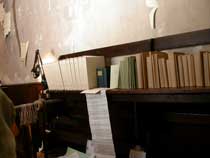
“Lost Meeting” has to do with creating new from old. That much I understand. The collaborating group of artists spearheaded by J. Morgan Puett and including the collective spurse and the composer David Lang did a lot of research into the old. They researched the archives surrounding Quakers in the region including those who would have been members of this little meeting on the Abington grounds. They documented old Quaker artifacts like clothing, dolls and other historical material. They restored the benches from the original now-crumbling building. They did some restoration to the meeting house which was a wreck apparently. They got the names of the original 47 Quaker families of the meeting. (image is books sitting on one of the original benches. The bench, which is still a bench, has been placed high on the wall. Other benches are used as work tables and in some cases they are installed diagonally in free space making kind of expressionistic lines or space dividers. I guess that’s part of the old-new idea, transforming the benches into something else — a shelf, a table, etc..)

When they were done with research, the group members went to work on the new. That’s where they lost me. Somehow the old material got translated into numbers and then the numbers got run through algorithms and the algorithms created new patterns. And the patterns keep being created because the project is ongoing. (this image shows a printout that describes the process (from right to left) of the devolution of an artifact into a new pattern. On the right is a photograph of a Quaker hat box and lid. Next is the first iteration of change, followed by several other iterations. There may be six or seven iterations in all.)
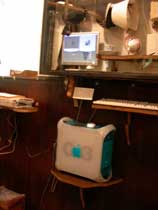
The little meeting house is a pattern workshop, with computers all over the place and a printer cranking out printouts of the new patterns as they are generated by the computers. What the space looks like is a kids clubhouse with things — patterns, tools, other stuff and clutter — hanging everywhere and little spaces and cubbyholes cut out here and there. It’s chaotic and claustrophobic and feels a little like a human beehive. What the new patterns represent is not clear to me, except that they are fuel for new projects by the artists which is what one of them told me. Spurse, by the way, is a play on the words disperse and spur. (image of more computers)
Anyway, I keep wondering how the new patterns have anything to do with Quakers, faith, people, and loss, either today or in the yesteryear when this meeting had a life. The closest things I could link it to in today’s world and I hesitate to say this are the cabin of the unabomber — or a beehive. Except that in both my examples there was and is a real world outcome — bombs and honey. Here, the outcome is not in the real world, it’s in generation of new patterns which have no application in the real world that I could see. (image below is a laptop generating one version of one pattern.)
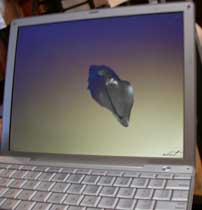
I kept thinking as I was being stepped through the process of algorithmic change by one artist or another “What’s necessary in all this?” What’s in it for me? In other words, why do we need these new patterns? Usually, necessity is the mother of invention. Here necessity seemed irrelevant, and invention was the end in itself. (image right is the same laptop as above, about a minute before the previous object appeared. It’s the same original object only at an earlier stage of development.)
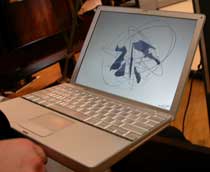
Like a dog catching a frisbee thrown by its owner, the pattern-making activity seems game-like and necessary to the participants but only mildly remarkable to a passerby.
Lang‘s instrumental music seems much more in tune with the idea of the old abandoned house in the woods which once was alive with voices and activity but for so many years signalled — with its abandonment — failure and loss. The music, which is outside and seems to emanate from the woods, is not heard inside the meeting house. Lovely, melodic and somewhat sad, the music connects with hymns, Quakers, and the idea of carrying your message outside your house and into the world, which is what Quakers (and all religions) try to do. In any event, it’s delightful. Lang is the founder and artistic director of New York’s “Bang on a Can.”
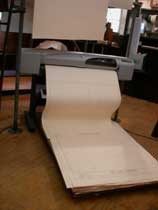
The spurse collective, the international group of architects, psychologists, scientists, statisticians, artists and skateboarders who worked on the project has done projects at Mass MoCA and elsewhere. There are some 40 spurse members (including Puett) and a fair number of them were in attendance at the opening. The group started in 1996 and began as a group of graduate students, member Rochelle (sorry I failed to write down her last name), a statistician from Toronto told me. (image is a printer which has been printing out the computer-generated patterns.)
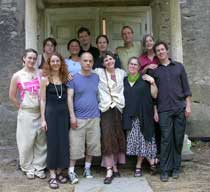
“Lost Meeting” is a communicative piece. It speaks to the artists who made it and who will be able to use some of the patterns generated here in future projects. To an outside viewer what it communicates is industry and confusion. And if that’s the intent that’s ok. I think industry is intended. I’m not sure about confusion.
Think of the piece as an anti-archive where generation of matter is important and organization is subsidiary. That may be the idea underneath it all — that archiving is false at base because it puts an artificial constraint on matter which, as we all know is chaotic and entropic. I don’t know. All I know is that with all that industry in that little cabin, I wish they were making honey instead of patterns. (image is the artists. I didn’t meet them all so don’t have everybody’s names. In the front row starting left is spurse member Rochelle, composer David Lang, J. Morgan Puett and curator Julie Courtney.)









